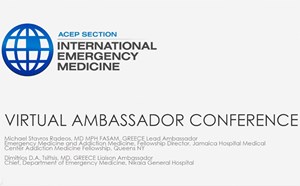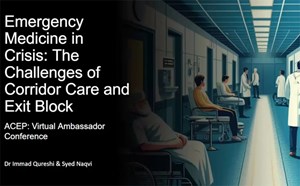India's Journey Toward Universal Health Care and Emergency Medicine
Watch this International EM Section Virtual Ambassador Conference webinar covering emergency medicine in India. Dr. Harshil Mehta presents.
Read the Full Transcript
- First of all good morning, everyone. Here in India, it's good evening and I'm out with my kid to play tennis, but I'll take time to represent my country. First of all, thank you very much for inviting us to represent India and we all know that India is a growing country and a developing country and the world's fourth largest economy now. So healthcare is also part of Indian economy and as we are on 75th year of independence and we are taking a big leap in the world health industry. So in last 10 years, a lot of things has happened and one of the most important things that happened was PMJAY that is Pradhan Mantri Jan Aarogya Yojana. So under that PMJAY, the people who are poor and under the poverty line. They are getting a lot of advantages through PMJAY and all the healthcare is free of cost. It is like NHS or social security in US. And so we're also developing into that stream and soon a lot of people will be covered under PMJAY Yojana. Next slide, please. So three pillars of Universal Health Care that is being developed under this primary care, emergency care, and definitive care. So emergency care is given the 33% of importance as far as you know healthcare is concerned in India and as in 2016, there was a law passed in India depending on the basis of EMTALA, that at all the patients who are coming to emergency department must be given free care irrespective of their pain capacity. And once the patient is stabilized then and then only can be transferred to definitive care. So emergency care is crucial and life-saving and it is given a prime importance along with definitive care and primary care. Next slide, please. So India was far behind in development of emergency medicine. So in US it was developed in 1968, but in India it was in 2009-10 when recognized emergency medicine residency program was started. So it's almost 40 years behind. But in last 15 years, if I can say then, the whole India is covered as far as emergency care is concerned. And the Indian government has also recognized emergency departments that are well-defined and well-managed emergency department must be there in all medical colleges as released to our competence. Like JCI, we have an updates in India that is . I think JCI would help. So, maybe tell a story requiring emergency department in all hospitals where the primary care is always that we focus, the care is being given. So, in that 15 years, emergency department or emergency medicine is well-developed and well-recognized in India and it has been a significant strides in structuring emergency care. Next slide, please. So what are three needs for emergency care? In India, what we see is inevitable emergencies that irrespective of readiness of health system, the necessitating improved planning and training. Then health equity and the third one is reduction in mortality. So, an organized emergency care should be given without any cost constraints to all the citizens. So that's why PMJAY comes into place and we see that within five to 10 years almost all the citizens of India would become the PMJAY scheme and as the law mandates that all emergency care should be given without any cost constraint or irrespective of their socioeconomic class. So enhancement in prehospital and emergency care would definitely reduce the mortality that's been happening. See India is not a developed country and the population is almost 1.5 billion now. So in that population, the value of health or the value of human being is less. But nowadays, we are increasing our emergency care so that all the people are getting proper emergency care, especially in trauma and we are saving lives because of the development of emergency medicine in India. Next slide, please. What is the current status? So we have two types of facilities in India, government and private. So the ambulance services are poor in government setup, but now in private setup, it is being developed very well. Emergency department beds. So in government facilities, we have a lot of patients and because of that, beds are inadequate, but in private setup, it is better than the government setup and hence the waiting area for the patients who are coming to private setup, the waiting area is developed in 10 minutes when there an emergency. So that is one of the good things in comparison with NHS were waiting area. Waiting time is much more but in waiting area in the private setup, the waiting there is much less. In government setup also, it is not as bad as inadequate as you can see. Workforce and training. So we are able to develop emergency physicians now and we have MD program, we have the MBA program. We are also training in MRCP, MD and MBA program. So a lot of programs are running and they are developing emergency medicine physicians so that you know, they can train the junior as well and they can deliver very important program care to the patients. In equipments, so in private we don't have any trouble in equipments, but yes, in government setup, the government is trying hard to get all the biomedical and critical equipments in place so that all the emergency patients can get proper medical care. Next slide. So what are top three challenges? One is really crowded as always, so it's very, very crowded because the healthcare facilities are not in companies with amount of population, then among this population. And calculate those population how much of the health care facilities. So all the emergency departments in government setup especially are overcrowded. And in private also now they're been working out because the emergency care is given free of cost within next 24 hours. Second thing is surge capacity. Again, the beds are not sufficient to cater 1.5 billion of people, and because of that, the beds are also lacking. And third one is staffing shortages. So shortages are there because of lack of doctors, nursing staff, but as we are training emergency physicians in various courses, so they are getting more and more numbers and because of their emergency care is given by proper training of emergency physicians into the emergency department. And lastly. So what future we expect to come in five to 10 years? So first thing is internet. India is not bad with the availability, although that internet especially in rural areas. So government is trying very hard. Next. Second is artificial intelligence. So in my department, we are using instruments or the automated instruments that can monitor the patients very well. And the third thing is drones. So we are... The government is also taking a pilot project to deliver bloods and medicines through drone to the remote areas, so that emergency patients can get all the required medicines if it is not available there. And because of this Universal Health Coverage, so as 1.5 billion of population would be covered, it is the main task in the 75 years of independence. So the commitment of the development of Universal Health Coverage, and 2022 was the milestone because it was the deadline to make the emergency department as a mandatory part to get the recognition of medical colleges in India. So, emergency departments from 2009 to 2024, if we say 15 years, a big leap in the development of emergency medicine doctors make in India. So last 15 years had been tremendous game changing and a milestone is developed in 2022. Next slide, please. So integrating technology is the important part. So in US and as well as India also, the HIS is be developed so that telemedicine, training, and robotics. So integrating technology is the key to develop proper emergency department or a critical emergency department that gives good care. And all that, the prehospital care, so telemedicine training of the emergency departments and robotics in the medicine can make a breakthrough in patient care and operational efficiencies. So these are the key areas that we would like to focus in next 10 years and let see how it goes and if it goes well then that can also change the game of the emergency medicine. Next slide, please. So to conclude on emergency care. So India's pursuit of establishing a robust emergency care framework is a relentless journey and it has just started, it has just started 15 years ago, and still we are thinking that it will takes time. But as we integrate technology like AI, Iot, and mobile health, it would overcome the challenge of this population. And as the nation ambassador in the next 25 years, so of the 100 years of independence, these advancements would promise to solidify India's commitment to universal health coverage so that none of the people would be without, and that is the goal that people first in next 25 years. So that is what we can say from Indian perspective that were we work where are and where we see all the effects of 100 years of our independence. So, thank you very much.



